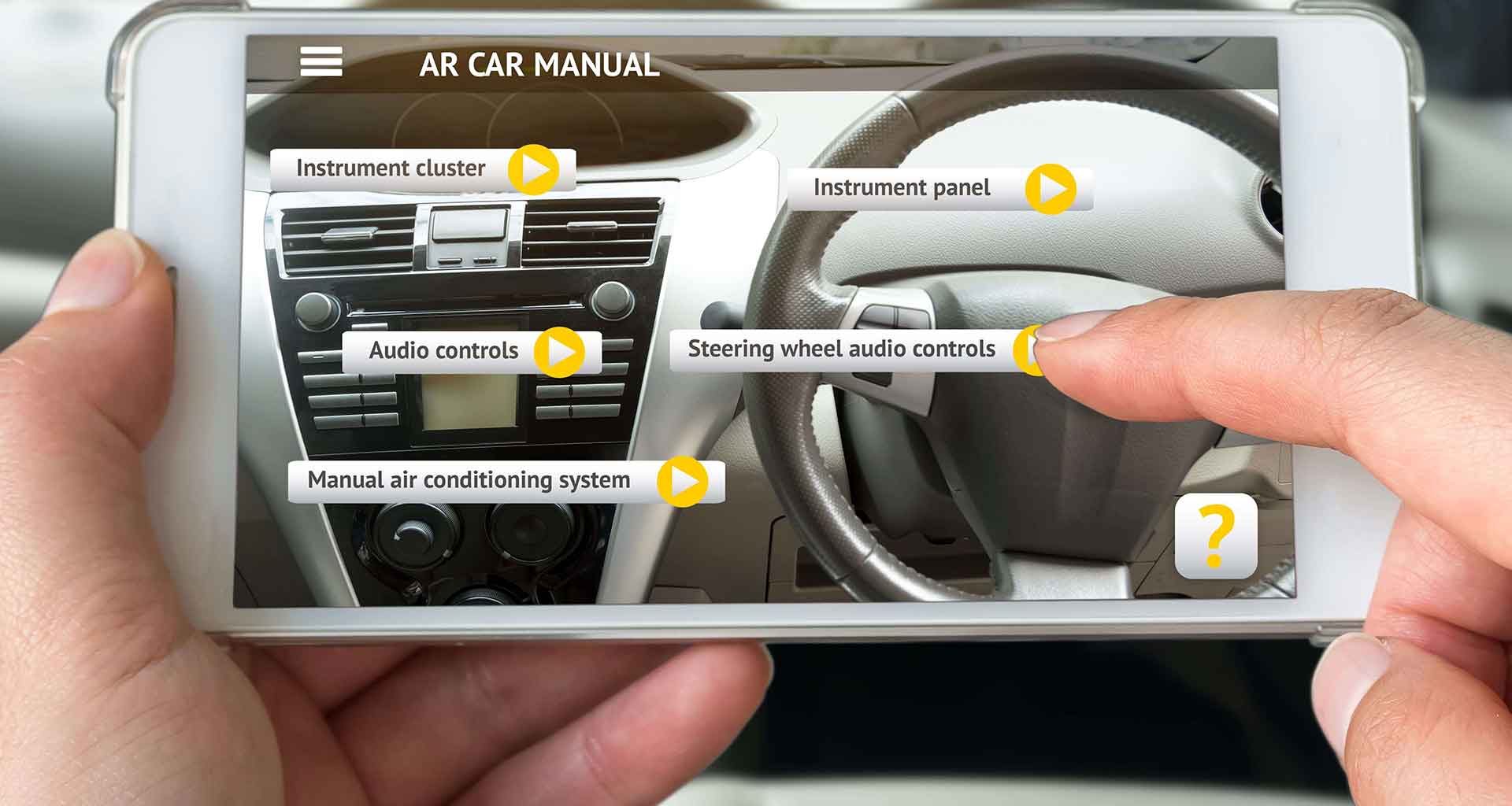Contents
AR user manuals give classic instruction manuals a whole new look. In this article, Techsee describes the growing trend of augmented reality instruction manuals and explores why they are becoming so popular. Learn how this technology can transform every aspect of the customer’s experience and discover the three key technologies that are necessary for an AR manual to work.
The Emergence of Augmented Reality Instruction Manuals
Instruction manuals: The words conjure up images of thick black-and-white tomes, boring, underused, maybe even untouched for years in our homes. But no longer.
Augmented reality has “blown the dust” off the instruction manuals of yesteryear.
Augmented reality (AR) is maturing as a technology and its adoption on mobile devices is growing steadily. According to research and consulting company Tractica, expanding use cases for mobile AR will lead to growth from 343 million unique monthly active users (MAUs) globally in 2016 to nearly 2 billion MAUs by 2022. Thanks to the mix of virtual and real world experiences it provides, AR technology offers users a more engaging and interactive experience, and is even more powerful when combined with artificial intelligence (AI) and computer vision capabilities.
Forward-thinking enterprises are using visual AR to enhance the entire customer journey. These companies are harnessing the power of AR to create an effective user engagement tool that connects its customers to its products. Every day, new opportunities for enterprise AR usage are discovered.
AR User Manual: FAQs
Before we explore the benefits of augmented reality user manuals, let’s first cover some FAQs on the topic.
What is an augmented reality instruction manual?
An augmented reality instruction manual takes an online user guide to the next level by overlaying the text and images with augmented reality technology in order to provide instructions to the user in an interactive manner.
Who uses augmented reality user manuals?
An augmented reality user manual is suitable for anyone who can benefit from step-by-step instructions or demonstrations in an interactive manner. It is used across industries – from explaining vehicle features to connecting a coffee machine, and everything in between.
How do augmented reality manuals work?
Augmented reality manuals are supported by sophisticated computer visualization technologies with Artificial intelligence deep learning capabilities. These technologies superimpose a computer-generated image on a user’s view of the real world, offering them a mixed reality experience that helps them better understand instructions or demonstrations.
Why Is AR so Effective in Instruction Manuals?
AR provides an effective digital interface that displays the content visually during initial setup, configuration, troubleshooting, regular maintenance, or for demonstration of proper usage. AR delivers an immersive experience, enabling the user to feel self-reliant, empowered, and in control, translating directly into a positive CX. Today’s AR-based instruction manuals bear no resemblance to the printed booklets of the past.
From the enterprise standpoint, AR manuals deliver better results, significantly alleviating the pressure on the service operation. For example, businesses using augmented reality instruction manuals have found that there:
- are less calls to customer service asking for help
- is a reduced need to dispatch technicians to customers’ homes
- are fewer NFF returns due to lack of customer knowledge about using the product.
AR User Manuals: Effective throughout the product life cycle
An augmented reality user manual can be extremely useful for the customer. It helps with unboxing and installing the product, explaining the various features it contains and troubleshooting any issues the customer may have. Let’s look through the benefits of using AR at each step of the product life cycle:
AR Unboxing and Installation Guide
One of its most popular applications of AR has been assistance with setup and installation. A typical AR unboxing guide provides superimposed instructions on top of a video representation of the physical product to be assembled. For example, Ikea’s AssembleAR app – built on Apple’s ARKit – utilizes the original diagrams and layouts of the paper IKEA manual but overlays them with animation and life-size references that simulate and clarify the self-assembly process. TechSee’s Virtual Technician uses augmented reality to accurately instruct customers on how to properly connect any electronic device from a modem to a coffee machine.
AR for Product and Features Introduction
Enterprises have also made good use of AR capabilities by providing users with an overview of their new product functionalities via visually immersive experience. Car manufacturers such as Mercedes Benz were early adopters of the AR manuals, allowing consumers to use their smartphone or tablet to get acquainted with every element on their new vehicle’s dashboard, with some manuals also including how-to information for basic repairs and maintenance, such as checking oil, refilling wiper fluid, etc. Today, many consumer-facing products make use of engaging AR-based user guides, which transform the initial interaction with appliances, electronic devices and consumers packaged goods into an easier, fun and improved experience.
AR for Troubleshooting
The lengthy troubleshooting process can be performed independently with the help of an intelligent, interactive visual guide that clearly explains the instructions in a step-by-step format. Troubleshooting involves a complex, non-linear process, beginning with identifying the problem, determining the correct sequence of actions based on the particular device or circumstance, communicating the solution to the customer, and testing to ensure the resolution was effective. In order to successfully manage this process, the AR user manual must be supported by mature and advanced computer vision and AI deep learning capabilities.
Technological Requirements of an AR User Manual
AR user manuals combine powerful and complex technologies to create a smooth and enjoyable customer experience. Let’s explore some of the complex functions at work behind the best augmented reality manuals:
AR Identification Capabilities
Computer vision uses object and motion recognition algorithms to identify images and objects in the user’s physical environment. This capability enables an AR app to recognize a product, device or part thereof, using advanced image processing — or when available, barcode and serial number reading — to identify the object. The higher its capacity for identification, the more powerfully it can perform: identification of the device itself, its different parts and ports, auxiliary parts such as cables, screws etc., as well as the capability to identify relevant elements in the physical space around it, such as wall sockets or jacks.
AR Movement Tracking
In order to align interactions between real and virtual objects in an AR environment so that the overlay is kept in position even through movement, a continuous, real-time precise understanding of the shape and location of the real objects in the environment must be acquired.
AI Learning Capabilities
Deep learning, the most advanced form of AI, enables independent learning of massive data sets. Unlike classic methods in which a human expert needs to define features (rules and attributes), deep learning can learn directly from data without human intervention. When powered by deep learning, an AR app can learn from each consumer interaction in order to continuously improve the process flow for future customer interactions. Data collected from each interaction may include an image bank of devices and models, relevant sequences of actions, possible results, etc.
Where Are We Heading with AR User Manuals?
What was once science fiction has already become everyday reality. AR has found a practical use as an instructional tool for many industries. As the perfect interface for visual guidance, augmented reality instruction manuals are considered the most suitable technology to meet customer demand for consumer product related CX excellence, especially in light of the increasing number of IoT devices flooding the market.
With the right features and capabilities, AR is poised to serve as the underlying technology to improve consumer-product engagement — or simply the future of user manuals — and conserve the environment by saving lots of paper at the same time.







